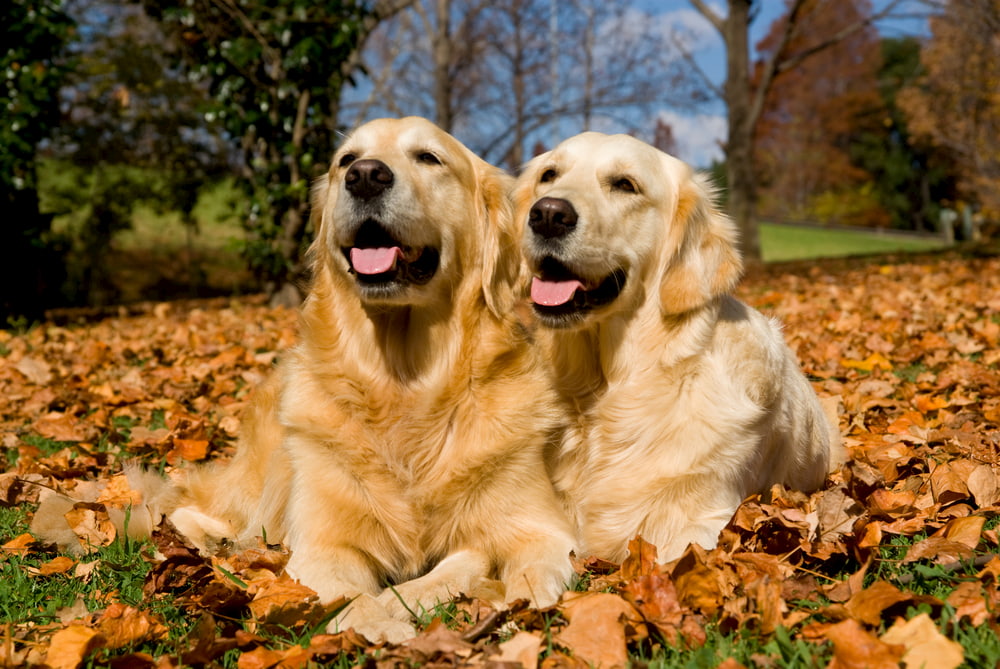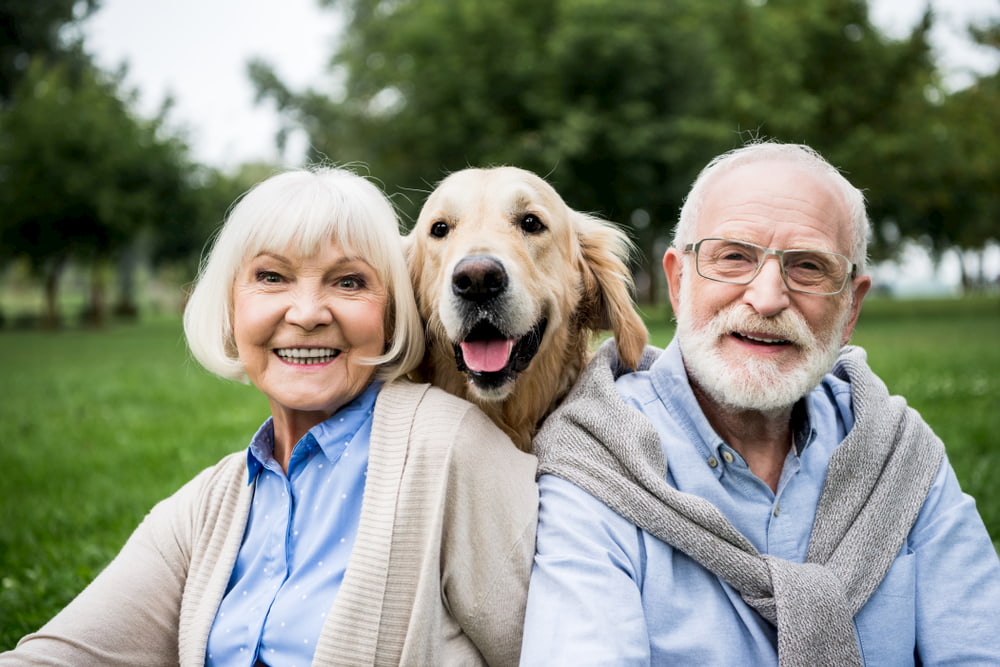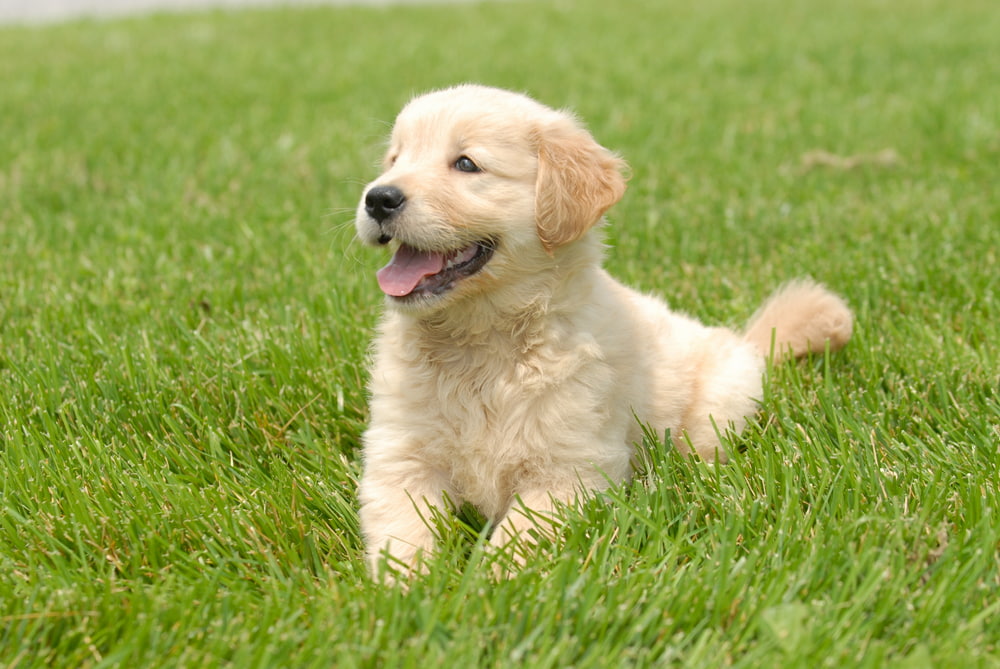Golden Retriever

Breed Details
- Average Height: Females = 21.5 to 23.5 inches; Males = 22 to 24 inches
- Average Weight: Females = 55 to 65 pounds; Males = 65 to 75 pounds
- Coloring: Various shades of gold, including cream and red
- Coat Type: Thick, water-repellent outer coat over a dense under coat
- Dog Breed Group: Sporting group
- Average Lifespan: 10-12 years
-
Key Personality Traits:
Affectionate
Calm
Good with Kids
Intelligent
Loyal
There’s a reason the Golden Retriever continues to reign as one of the nation’s most popular dog breeds. Friendly, loyal, patient, and intelligent, Goldens possess the traits people often seek in a four-legged family member.
Golden Retrievers are not suited for everyone, though. They’re high energy pups, they shed a lot, and are at a higher risk of developing a number of health problems.
To help you make an informed decision about Golden Retriever adoption, we asked experts most familiar with this breed for their insights.
History and Origin

Once thought to be descendants of Russian track dogs (known as Russian Retrievers), experts now agree that Golden Retrievers originated in the rugged terrain of the Scottish Highlands during the mid-nineteenth century. Dudley Marjoribanks, a British Parliament member who later became a baron (and known as Lord Tweedmouth), wanted a dog capable of swimming long distances to retrieve ducks and other waterfowl.
In 1868, Tweedmouth bred a male Wavy Coated Retriever named Nous with Belle, a Tweed Water Spaniel (this breed is now extinct). “The resulting dogs included several yellow puppies that became the foundation of the Golden Retriever,” says Dr. Ann Hubbs, a veterinarian and chairperson of the Golden Retriever Club of America’s (GRCA) Health and Genetics Committee.
The Kennel Club of England officially recognized the Golden Retriever as a distinct breed in 1911, during which time the dogs also started to appear in the United States. In 1925, the American Kennel Club welcomed the Golden as its 78th breed.
The Golden Retriever dog has since proven itself to be more than a proficient hunter. They also excel as therapy, service, guide, and search and rescue dogs. They also rock at organized dog events like obedience, agility, and rally trials, says Hubbs.
“Most of all, Goldens are beloved family members who are equally comfortable with a hike, swim, romp in the snow, snuggle on the sofa, or taking up most of your bed at night,” she adds.
Types of Golden Retrievers
Goldens can vary slightly in appearance by geographic region. These variations include:
- American Golden Retrievers
- British Golden Retrievers
- Canadian Golden Retrievers
The American Golden Retriever, who tends to be leaner with eyes that are more slanted and a darker coat, says Dr. Ashley Barnes, medical director at Louisville Family Animal Hospital in Colorado and a member of the Morris Animal Foundation Golden Retriever Lifetime Study.
“British Goldens tend to be more muscular with blockier heads and rounder eyes, and lighter in color as well,” says Barnes. “Canadian Goldens tend to be taller with shorter and thinner hair coats.”
Golden Retriever Physical Characteristics

Large, strong, and athletic, female Golden Retrievers measure between 21.5 and 23.5 inches tall and weigh from 55 to 65 pounds. Their male counterparts are slightly larger, standing between 22 and 24 inches tall and weighing between 65 to 75 pounds.
Like humans however, Golden Retrievers don’t fit neatly into any category. “My female golden is 77 pounds and not overweight,” says Barnes. (Your veterinarian is the best person to help establish an ideal weight for your dog.)
Within the breed, there are two main types, says Dr. Jessica Romine, a veterinarian with BluePearl Specialty and Emergency Pet Hospital in Southfield, Michigan. “A leggier, more athletic type favored by active hunters, and a blockier, shorter type favored by most show breeders,” she says. “It is important to know which type you’re getting, as it will impact their activity level and propensity for weight gain.”
Golden Retriever colors come in a range of golden hues, from creamy white to red. The outer coat is thick and water-repellant, a result of its breeding history. “Their roots as Retrievers working in the hills of Scotland means they have a warm, insulating coat with a protective top coat,” says Romine. The coat’s texture, which has been described somewhere between silky and coarse, can be straight or slightly wavy.
Goldens usually mature physically by 2 years old and mentally at around 3 years old, experts say, however “Sometimes, if you get a really goofy one, the answer is never,” adds Bobbie Greco, president of Golden Re-Triever Rescue of New Jersey.
Golden Retriever Personality Traits

Golden Retrievers possess a number of endearing qualities that have helped cement their spot as one of the nation’s most beloved breeds. Foremost, they’re kind and loving. “Their biggest goal in life is to please their humans,” says Greco. “They’re very affectionate and extremely loyal. They’re the definition of unconditional love.”
Goldens are also smart and eager to learn, which is a huge plus when it comes time to train them.
The typical Golden Retriever is a bundle of energy and can destroy things (including your favorite pair of shoes or that expensive sofa) if not given enough exercise. “They are also super friendly,” says Barnes. “Given this, along with their energy, they tend to get overly excited with new people and are known to jump and turn in circles.”
Because Goldens are people-oriented, patient, and friendly, they tend to do well with kids and other pets. “This does mean they enjoy and benefit from training and need help building confidence to be sure they do not become overly-attached leading to separation anxiety,” adds Romine.
Golden Retriever Care Guide

As large, high-energy dogs who shed (a lot!), Golden Retrievers have a few specific needs when it comes to diet, exercise, and grooming.
Diet and Nutrition
Veterinarians often recommended feeding Golden Retriever puppies a large breed puppy food. “And at about a year of age they can be transitioned to an adult maintenance food. Large breed adult food is a fine choice as well,” says Romine.
Large breed puppy diets restrict calcium and calories to prevent rapid growth, a factor that puts these dogs at an increased risk for developing orthopedic disease.
Because Goldens are big and have boundless energy, they have ravenous appetites, which if unchecked, can put them at a greater risk for obesity. Ask your veterinarian to help you calculate your dog’s daily caloric needs based on age, spay/neuter status, and activity level, recommends Dr. Julia Labadie, epidemiologist at Morris Animal Foundation. “Try to limit the number of treats to less than 10 percent of your dog’s daily calories and encourage physical activity. Have your veterinarian show you how to assess your dog’s body condition score so that you can better monitor for any changes at home.”
Any diet you choose for your Golden Retriever should be complete and balanced. This means the food meets or exceeds nutritional requirements, and that individual ingredients have been balanced for optimal absorption and benefit. Look for a nutritional adequacy statement on the label from the Association of American Feed Control Officials (AAFCO), the organization that sets nutritional guidelines for pet foods. Always start any conversation about diet with your veterinarian.
Exercise and Activity
There are two main reasons why Golden Retrievers need ample exercise. For one, the typical Golden is a bundle of energy. “They are not as high energy as the herding breeds like Border Collies, but also don’t tend to be couch potatoes,” says Barnes. They’re also ravenous eaters, which puts them at a higher risk for obesity.
Exercise can come in the form of walks, play, or swimming, says Barnes. “I would say the average is about one hour of activity per day, with younger dogs needing more than older dogs.”
Golden Retrievers also need focused play, which can be in the form of a job, a trait that also makes them great therapy and service dogs, says Greco. “Given that they are so smart, this is a very natural thing for them as they are quick learners and, again, are always looking to please.”
Grooming and Nail Care
Get used to your Golden Retriever shedding a lot. “They are big shedders, definitely more than Labs and other shorter coat breeds,” says Barnes. “They shed year round, typically blowing their coats about twice per year.”
Goldens also need to be brushed about every one to two weeks, although some may need more, especially if they’re blowing their coats, says Barnes. “I like to use a rake comb first to help get the thick undercoat, followed by a more standard brush.”
Bathing is based on how dirty your Golden gets, says Barnes. “In general, bathing is needed every one to two months with a dog specific or baby shampoo.”
Nail trimming somewhat depends on their exercise level, says Barnes. “Dogs that do a lot of walks (especially on concrete) will wear their nails down naturally and need fewer nail trims. A good average is once every one to two months for nail trims.”
Golden Retriever Health Issues

Goldens Retrievers are unfortunately at risk of developing several major diseases. This doesn’t necessarily mean they acquire these diseases, but knowing their predispositions can help you be better prepared. These are some of the most common disorders affecting this breed.
Cancer (especially hemangiosarcoma and lymphoma): Based on the 1998 GRCA National Health Survey, the lifetime risk of hemangiosarcoma and lymphoma are one in five and one in eight, respectively, says Labadie. “Hemangiosarcoma is a very deadly cancer that affects many breeds, but seems to be especially common in Goldens.”
For more information about cancer and other illnesses in Goldens, follow The Golden Retriever Lifetime Study (GRLS), an initiative that follows over 3,000 Golden Retrievers throughout their lifetime.
Heart Disease: Golden Retrievers are at risk for genetic heart conditions such as subaortic stenosis—fibrous tissue below the aorta that causes the blockage of blood flow through the heart; and dilated cardiomyopathy, which interferes with the heart’s ability to pump normally. They’re also predisposed to pericardial effusion, says Romine, which is “bleeding around the heart, either as its own disease or secondary to hemangiosarcoma in the region.”
Joint Issues: Dysplasia (abnormal formation of joint) of the hip and elbow is common in large breeds, like Golden Retrievers. “These tend to be more congenital so it is important that the parents are screened for these diseases prior to being bred,” says Barnes.
Cataracts: This is one of the top eye diseases found in Goldens. A cataract is a cloudiness of the eye that can result in partial or full blindness. Juvenile cataracts are specifically prevalent and is usually genetic, says Barnes.
Hypothyroidism: Hypothyroidism is a decrease in thyroid levels that can lead to weight gain, a brittle coat, and in some cases, coma. “It usually appears in older Goldens,” says Barnes.
Ear and Skin Problems: Golden Retrievers are prone to both environmental and food allergies, which typically appear as itchiness, ear infections, and skin infections, says Barnes. Although ear infections are secondary to allergies, “We can see them in dogs that do a lot of swimming as well,” she explains.
Interesting Golden Retriever Facts

Golden Retrievers have held the record as one of AKC’s Top 10 most popular dog breeds for decades.
In the 144 years of the Westminster Kennel Club dog show, no Golden Retriever has ever won Best in Show, says Greco.
President Gerald Ford had a Golden Retriever named Liberty, which many say helped propel the breed’s popularity in the United States.
Goldens are naturals in the water. Chalk it up to their lineage (they were bred as waterfowl hunters) and their athletic build.
A Golden Retriever named Comet was the Tanner Family’s dog on the sitcom Full House.
Popular Golden Retriever Mixes

Given the fact that Goldens are beloved far and wide, it’s no surprise that Golden Retriever mixed breed dogs are growing in popularity. Here are some of the most popular Golden Retriever mixes:
Goldadors (Golden Retriever and Labrador Retriever mix): They’re described as loyal, affectionate, and gentle.
Goldendoodles (Golden Retriever and Poodle mix). “Goldendoodles tend to be quite smart as both of the original breeds tend to be smart dogs,” says Greco.
Goberians (Golden Retriever and Siberian Husky mix). Energetic, smart, and affectionate, these pups take after both parents.
Golden Chi (Golden Retriever and Chihuahua mix). Because they’re opposite in size, this mix isn’t bred the old-fashioned way but by in vitro fertilization. The result is a medium-sized pup that’s smart and gentle, but with the Chihuahua’s characteristic feistiness.
Golden Retriever Adoption Tips

If you’re considering Golden Retriever adoption, you might have a better chance of going through a breed-specific rescue. “Goldens sometimes do end up in shelters but it is rare and if it happens, there are usually quite a few applications for them,” says Greco.
If you do go this route, keep in mind that adoption fees at breed-specific rescues tend to be higher than at standard shelters. Additionally, “The ones I’m familiar with have very strict protocols that are followed, ensuring that these dogs find the best forever home possible,” says Greco.
Regardless of where you adopt your Golden Retriever, do ample research first, offers Greco. “They are amazing, beautiful, incredible dogs but they are not for everyone. You need to know your lifestyle and understand what the commitment is before taking on a Golden (or any dog for that matter).”
Golden Retriever Rescues
There are several breed-specific rescues for Golden Retrievers located throughout the country. Here are just a few to consider.
National: The GRCA’s National Rescue Committee provides networking services for nearly 100 local rescues.
Eastern region: Golden Re-Triever Rescue of New Jersey Incorporated works to find homes for Goldens throughout New Jersey and parts of New York state.
Western region: Southern California Golden Retriever Rescue. Rehabilitates and finds homes for Goldens in the southern part of the state.
Mountain region: Golden Retriever Rescue of the Rockies re-homes about 300 Goldens each year.
Midwest region: As Good as Gold – Golden Retriever Rescue of Illinois. Their dual mission is to find homes for Golden Retriever and mixes, and to educate the public on proper husbandry.
Golden Retriever FAQs

If you decide to welcome a Golden Retriever into your home, you’ll be given love, loyalty, and adventures to last a lifetime. But it’s important to have all of the facts about this breed’s disposition and care needs. Here are some frequently asked questions about Golden Retriever dogs:
Do Golden Retrievers Shed?
Yes, Golden Retrievers shed a lot. Living with a Golden means you’ll be doing a lot vacuuming. “They shed a good amount year round with two big sheds a year,” says Barnes.
How Long Do Golden Retrievers Live?
Goldens live about 10 to 12 years, although this is dependent on family history and the type of diet and care they receive.
Are Golden Retrievers Good with Kids?
Goldens are usually good with children, says Barnes. “They enjoy being around people and tend to be gentle and patient.” Of course, all dogs are individuals, and training and early socialization are important regardless of breed.
When Do Golden Retrievers Stop Growing?
Most Golden Retrievers stop growing between 1 and 2 years of age, says Hubbs. “Early neutering of Golden Retrievers may delay this and some studies suggest that delay can increase adult size and the risk of orthopedic diseases such as hip dysplasia.”
Do Golden Retrievers Bark a Lot?
If you’re wondering whether Golden Retrievers are big barkers, the answer is—it depends. “They are not known for being barkers but some Goldens bark a lot and some don’t,” says Barnes. “It is more dependent on training in this breed.”
How Fast Can a Golden Retriever Run?
Golden Retrievers have been known to reach speeds upwards of 25 mph, says Greco.
Pictures of Golden Retrievers
Their golden coats, loving smiles, and sweet eyes mean that we can stare at pictures of Golden Retrievers for hours upon hours! If you feel the same way, browse our gallery of cute Golden Retriever pictures to get your fix.





























